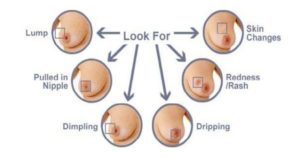
What is Breast Cancer? How to manage it? What are the precautions to be taken? What are the signs and symptoms? What is the cause of this disease? How to treat it? How can homeopathy help you? All of this answered, in this post and of course our doctors always there to help you. Just fill in your details in the form down below and we will answer all your questions for FREE!

Define breast cancer?
Breast cancer is entirely a women’s disease but, in some cases, it can develop in men too.
Commonly breast cancer starts in the cells lining the ducts and it is called ductal cancer.
Some cancer starts in the cells lining the lobules called lobular cancer.
How many stages of breast cancer?
Stages of breast cancer:
Stage 0
In stage 0 of breast cancer, there is called non-invasive type. There is no invasion of cancer cells or non-cancerous abnormal cells into neighboring normal tissue.
Stage I
It is divided into IA and IB stages.
• IA stage: The tumor is localized and does not spread outside the breast. It measures up to 2cm. There is no involvement of lymph nodes.
• IB stage: Some cancer cells are found in the lymph nodes measuring between 0.2 mm and 2 mm. the tumor may or may not be present in the breast tissue measuring less than 2 cm.
Stage II
It is divided into IIA and IIB stages.
• IIA stage: Cancer cells are present in the axillary lymph nodes but not in the breast. A tumor that is found in the axillary lymph nodes measures less than 2cm.
• IIB stage: Tumor that has spread to the axillary lymph nodes measures 2 to 5cm.
Stage III
It is divided into IIIA, IIIB, and IIIC stages.
• IIIA stage: Cancer cells of any size get clumped together are found in the axillary nodes and they stick to other neighboring structures.
• IIIB stage: The cancer cells of any size chest wall and/ or skin of the breast.
• IIIC stage: Cancer has spread to lymph nodes above or below the collarbone; it may have spread to axillary lymph nodes or to lymph nodes near the breastbone. If the tumor is present in the breast it may have spread to the chest wall and/or the skin of the breast.
Stage IV
The spread of the breast cancer occurs beyond the breast, lymph nodes or to other organs of the body, such as the lungs, skin, bones, liver, or brain.
What are the major factors in developing the breast cancer?
• Genetic Causes
-People with family history of breast cancer are at more risk of developing the disease.
-The risk is highest if the patient having breast cancer is a first-degree relative (mother, sister, daughter).
• Hormonal Causes
-If in a woman periods starts at an early age (12 or younger) or she has a late menopause (55 or older), then they are at a slightly higher risk of developing breast cancer.
-Oral contraceptive pills slightly increase the risk of breast cancer than women who have never used them.
-The risk of developing breast cancer increases if the women have no child or deliver the baby after the age of 30.
• Lifestyle and Dietary Causes
-High dietary intake of fat and being overweight or obese is one of the risk factors for acquiring breast cancer, particularly in postmenopausal women.
-Greater the amount of smoking tobacco and the earlier in life smoking begins the higher the risk for breast cancer.
-The use of alcohol also contributes to the development of breast cancer.
-Women who consume two to five alcoholic beverages per day have a higher risk of breast cancer as compared to the non-drinkers.
• Environmental Causes
-If a woman is receiving radiation therapy to the upper body for treatment of disease before 30 years of age they have a higher rate of breast cancer as compared to the general population.
What are the warning signs to detect breast cancer?
• Discharge of blood from the nipple.
• Size and shape of the breast changes.
• Formation of peeling, scaling or flaking of the nipple or breast skin.
• Skin of the breast becomes red and pitted, appears as the skin of the orange.
• A breast lump or thickening feels different from the surrounding tissue.
• Change to the skin over the breast and dimpling occurs.
• Nipple becomes inverted.
What is the differential diagnosis of breast cancer?
• Fibroadenoma.
• Breast abscess.
How to inspect the presence of breast cancer?
• Examination of the Breast.
• Careful palpation of the breasts, the armpits, and the areas around the collarbone.
• Thickening of the lump is palpated.
• Mammography.
• Ultrasound.
• MRI.
• Biopsy.
• Blood test.
How to treat breast cancer?
• Surgery.
• Breast-conserving surgery.
• Radiation therapy.
• Chemotherapy.
• Hormone therapy.
How diet and precautions help in breast cancer?
Management:
• Assure the patient about the quality of care.
• Advice changes in lifestyle and dietary changes.
• Regular screening after the treatment.
Diet:
• Green and black tea.
• Tomatoes contain lycopene that helps to fight against cancer.
• Sweet potatoes.
• Soy products.
• Fruits rich in vitamin C.
e.g. oranges, lemon, papaya, grapes, etc.
• Garlic enhances the immunity.
• Vegetables like broccoli, cabbage, carrot, and cauliflower.
What are the complications of breast cancer?
• Spread of cancer to other parts of the body.
• Swelling in the breast with pain is a side effect of radiation therapy.
What is the indicated medicine of breast cancer?
Some of the homeopathic medicines which can help in case of breast cancer. These are:
• Conium
• Carbo animalis
• Hydrastis
• Plumbum
• Graphites
For more information, you can visit MayoClinic and health.com.